Volkswagen Golf Mk7
| Volkswagen Golf Mk7 | |
|---|---|
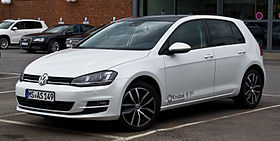 | |
| Overview | |
| Manufacturer | Volkswagen |
| Production | 2012–2020 (Europe) 2013–present (China) 2015–2020 (Brazil) 2014–2021 (Mexico) |
| Model years | 2013–2020 (Europe) 2015–2021 (North America) |
| Assembly |
|
| Designer |
|
| Body and chassis | |
| Class | Compact car/small family car (C) |
| Body style |
|
| Layout | Front-engine, front-wheel-drive Front-engine, all-wheel-drive (Optional with some engines, standard on the Golf R) |
| Platform | Volkswagen Group MQB |
| Related | Volkswagen Golf Sportsvan Audi A3 Mk3 SEAT León Mk3 Škoda Octavia Mk3 |
| Powertrain | |
| Engine | |
| Electric motor | AC electric motor 136 PS (100 kW; 134 bhp) (e-Golf) |
| Transmission | |
| Battery | 62 kWh (e-Golf) |
| Dimensions | |
| Wheelbase | 2,631–2,637 mm (103.6–103.8 in) 2,619–2,629 mm (103.1–103.5 in) (facelift) |
| Length |
|
| Width | 1,791–1,799 mm (70.5–70.8 in) |
| Height | 1,435–1,514 mm (56.5–59.6 in) |
| Kerb weight | 1,205–1,500 kg (2,657–3,307 lb)[1][2] |
| Chronology | |
| Predecessor | Volkswagen Golf Mk6 |
| Successor | Volkswagen Golf Mk8 Volkswagen ID.3 (for e-Golf) |
The Volkswagen Golf (Mk7) (also known as the Golf VII)[3] is a small family car produced by German automobile manufacturer Volkswagen, as the seventh generation of the Golf and the successor to the Golf Mk6. It was introduced in Berlin on 4 September 2012, before a public launch at the 2012 Paris Motor Show and marketed for the 2013 model year.[4] Cars reached Volkswagen dealers in the Golf's European domestic market on 10 November 2012.[5]
The Golf Mk7 uses the same MQB platform as the third-generation Audi A3, SEAT León and Škoda Octavia. At its introduction in 2013, it won the Car of the Year Japan Award, the first time it was awarded to a European product.
On 10 November 2016, VW presented a facelift of the Golf Mk7.[6] In December 2019, it was replaced by the Volkswagen Golf Mk8.[7] However, production of e-Golf[8] and Golf Variant will stop the following year, precisely in mid-2020 for Golf Variant.[9]
Overview[]


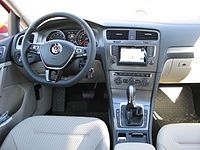
Compared with the previous generation, the Golf Mk7 has a roomier cabin with greater shoulder room for the front and rear passengers, more rear legroom, and more boot space. It is 20 mm (0.8 in) wider than the Mk6, with a 59 mm (2.3 in) longer wheelbase.
Engine options at launch include 1.2 and 1.4-litre turbocharged petrol engines, with 85 PS (63 kW; 84 hp) and 140 PS (103 kW; 138 hp) respectively, and 1.6 and 2.0 -litre diesel engines, with 105 PS (77 kW; 104 hp) and 150 PS (110 kW; 148 hp) respectively.[10] The 1.6 TDI BlueMotion Concept has a theoretical combined fuel consumption of 3.2 l/100 km (88 mpg‑imp; 74 mpg‑US) and anticipated 85 g/km CO
2 emissions.[11]
Available body styles are three and five door hatchbacks (including high-performance Golf GTI and Golf R models), and a five-door station wagon (known as the SportWagen in the United States, first advertised in May 2015).[12] Sales of the three-door hatchback were not as strong as previous generations, and it was dropped with the launch of the eighth generation model in late 2019.
At launch in the US market, Volkswagen also offered the Golf Sport model. About 650 of these SE four-door models were built, equipped with the six-speed automatic transmission. Offered in either Pure White or Platinum Gray, the Sport model is visually enhanced with a striking bodykit that includes a front lip spoiler, side skirts, a rear valence, a larger rear spoiler, and chrome exhaust tips.[13]
The Golf went on sale in the UK in early January and was released in Australia in April 2013.[14][15]
In Brazil, the Golf Mk7 went on sale in September 2013, only in the Highline and GTI trims,[16] along with the Comfortline trim,[17] which was made available from March 2014. All models were imported from Germany until 2015, when local assembly commenced.
New safety systems[]
- First series production Volkswagen with Proactive Occupant Protection, which will close the windows and retract the safety belts to remove excess slack if the potential for a forward crash is detected. Seat belt retraction in a crash situation was also a feature on the Mk6 for the front two seat belts. The front two belts retract if it was buckled in, however if the occupant is relatively light, the seat belt gradually extends in a forward crash situation.[18]
- First series production Volkswagen with multi-collision brake system to automatically brake the car after an accident in order to avoid a second collision.
- adaptive cruise control (optional)
- collision avoidance system (Front Assist) with City Emergency Braking (optional)
- lane-keeping assistant (optional)
- driver fatigue detection (optional)
- traffic sign recognition (optional)
- automatic parking system (optional)
- rear assist camera (optional)
Station wagon[]
The station wagon of the Golf was revealed at Geneva Motor Show in March 2013.[19][20] It is marketed as the Golf Variant in Germany and Golf SportWagen in the United States and Canada, replacing the Jetta SportWagen nameplate previously used in the US.
The Golf Estate's loadspace volume has been expanded from the 505 litres of its predecessor to 605 litres (loaded up to the back seat backrest), versus the 380 litres of the Golf hatchback. Loaded up to the front seat backrests and under the roof, the new Golf Estate offers a cargo volume of 1,620 litres (versus the 1,495 litres of the Golf Estate Mk VI). The rear seat backrests can be folded remotely via a release in the boot.
Four petrol engines and three diesel engines are available, ranging from 85 to 140 PS in the petrol and 90 to 150 PS for the diesel engines.
For the first time, the Golf Estate will also be available as a "full" BlueMotion model (with other modifications including revised aerodynamics). This model uses a 1.6-litre diesel engine producing 110 PS, has a six-speed manual gearbox, and is expected to achieve a combined fuel consumption of just 85.6 mpg (equivalent to 87 g/km of CO2).
The Golf station wagon is available in S, SE and GT (Trendline, Comfortline and Highline in Canada) (GT is SEL in the USA) trim levels. There is also a Golf Estate R, using the same EA888 2.0 engine found in the MkVII Golf R hatchback. The Golf Variant is also built as a rugged version called "Alltrack" with slightly-raised suspension, body cladding, and all-wheel drive.

Golf Variant

Golf Variant
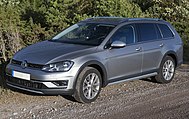
2015 Golf Alltrack (pre-facelift; Europe)

2016 Golf Alltrack (pre-facelift, UK)
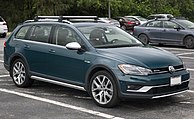
2018 Golf Alltrack (facelift; US)
e-Golf[]


The production version of the 2014 Volkswagen e-Golf was unveiled at the 2013 Frankfurt Motor Show.[21] According to VW the e-Golf has a practical all-electric range of 130 to 190 km (81 to 118 mi), with an official NEDC cycle of 190 km (118 mi), and the winter range is expected to be 80 to 120 km (50 to 75 mi).[22] The 2015 e-Golf has a range of 83 mi (134 km), and combined city/highway efficiency of 116 miles per gallon gasoline equivalent (MPGe).[23] Production of vehicles destined for retail customers began in March 2014.[24]
On 14 February 2014, Volkswagen launched sales of the e-Golf in Germany, with pricing starting at €34,900 (~US$47,800).[22] On 11 March 2014, Volkswagen opened ordering for the e-Golf in the UK, priced at GB£30,845.[25] UK deliveries began at the end of June.[26] The U.S. version of the 2015 e-Golf did not have a liquid-cooled battery pack because strict testing showed high ambient temperatures did not affect battery performance.[27]
In Norway, the e-Golf became available for pre-order on 25 February 2014 for delivery in June 2014. More than 1,300 cars were ordered that same day.[28] By 3 March 2014, nearly 2,000 cars had been pre-ordered.[29] Prices range from 251,800 kr (~US$42,000) for the basic model to 302,000 kr (~US$50,000) with all available options,[30] comparable to the cheapest petrol and diesel models.[31] The VW e-Golf was the top selling plug-in electric car in July 2014 with 391 units sold and representing 34.4% of the Golf nameplate sales (1,136), which was Norway's top selling new car that month.[32][33] The e-Golf was again the top selling electric car in August 2014 with 467 units sold, representing 43.4% of the Golf nameplate sales that month (1,075). In two months and a half a total of 925 Volkswagen e-Golf cars have been sold in Norway, surpassing initial Model S sales which delivered 805 units during its first two months in the Norwegian market.[34][35] A total of 1,358 units have been sold in Europe through August 2014.[36]
U.S sales are slated to start in selected markets in November 2014 at a price for the SEL Premium model starting at US$35,445 before any applicable government incentives, plus US$820 destination and delivery.[37] Volkswagen of America sold 119 units of the e-Golf during November 2014, the first full month of sales for the vehicle.[38]
In Spain, 2015, the price of a brand-new e-Golf was at 35,500 euro.[39]
The 2017 version has an improved battery pack of 35.8 kWh giving a range of 300 kilometres (190 mi) on the NEDC scale and an EPA rating of 125 miles (201 km).[40]
E-Golf was the last hatchback version of the Golf Mk7 produced in Europe, with production continuing until late December 2020, unlike all other powertrains discontinued in 2019, due to high demand.[8]
As of April 2021, the e-Golf is still sold in China with two models available known as: Golf·Pure Electric Motor and Golf·Pure Electric Motor Pro.[41]
Golf GTE[]
This section needs additional citations for verification. (October 2014) |
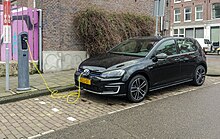


The Golf GTE plug-in hybrid is driven by two power sources: a 1.4-litre 110 kW (150 PS; 148 hp) TSI direct-injection petrol engine and a 75 kW electric motor. Together, they combine to produce power of 150 kW (204 PS; 201 hp) and 350 N⋅m (258 lb⋅ft) of torque, with a theoretical range of 933 km (580 mi). Using the electric motor alone, the GTE is capable of speeds of 130 km/h (81 mph). With the TSI engine as well, the Golf GTE can accelerate from 0-100 km/h (62 mph) in 7.6 seconds and on to a top speed of 215 km/h (134 mph). The Golf GTE shares the basic powertrain hardware with the Audi A3 Sportback e-tron but the software controls are different.[42] The Golf GTE also shares the same plug-in hybrid powertrain with the Volkswagen Passat GTE, but the Passat has a larger 9.9 kWh Li-ion battery pack.[43]
In EV mode, the Golf GTE has an all-electric range of 50 km (31 mi). The all-electric mode can be activated at the push of a button. Under the New European Driving Cycle, combined fuel economy is 1.50 L/100 km (157 mpg‑US) equivalent.[44] The electric power can also be saved—for example when driving to a zero-emissions zone. The 8.8 kWh lithium-ion battery can be charged in around three and a half hours from a domestic mains outlet, or two and a half hours from a domestic wallbox. The battery weighs 120 kg (265 lb), giving the GTE a total kerb weight of 1,520 kg (3,351 lb).

The Golf GTE uses a six-speed DSG gearbox with a triple-clutch system specially developed for hybrid vehicles. The electric motor is integrated into the gearbox housing, while further hybrid components include power electronics and a charger. An electro-mechanical brake servo and an electric air conditioning compressor make for energy-efficient braking and air conditioning.
Inside as on the outside, the Golf GTE features blue highlights where the GTI has red. This includes stitching on the steering wheel, gear lever gaiter and seats, and a blue stripe in the tartan pattern on the sports seats. A 5.8-inch touchscreen display is standard, the eight-inch Discover Pro satellite navigation system with DAB radio and Bluetooth is a £1765 option, and includes bespoke functions for electric vehicles, including the ability to identify potential destinations on electric range, and electric charging points. The GTE will also feature an e-manager which allows the driver to preset vehicle charging, as well as interior cooling or heating. These functions can also be operated remotely using the Volkswagen Car-Net app on a smartphone: a three-year subscription will be included in the UK.
The first GTE units were registered in Germany in August 2014,[45] and it was the second-best selling plug-in hybrid in Europe in 2015 with 17,282 sales.
Golf GTD[]
This article needs attention from an expert in Automobiles. (February 2017) |
This section does not cite any sources. (February 2016) |



The MK7 GTD is powered by a 2.0-litre turbocharged common rail diesel engine with 184 PS (135 kW; 181 hp). Maximum torque—the characteristic that arguably best defines the easily accessible performance of the GTD[citation needed]—has risen from 350 N⋅m (258 lb⋅ft) to 380 N⋅m (280 lb⋅ft) from 1,750 rpm. The Golf R, in comparison, has 380 N⋅m (280 lb⋅ft) from 1,800 rpm. Acceleration from 0-100 km/h (62 mph) takes 7.5 seconds, while the top speed is 227 km/h (141 mph). The GTD has a combined fuel consumption of 4.18 L/100 km; 56.2 mpg‑US (67.5 mpg‑imp), making for CO
2 emissions of only 109 g/km. With the optional six-speed DSG, fuel consumption is 4.50 L/100 km; 52.3 mpg‑US (62.8 mpg‑imp) and CO
2 emissions of 119 g/km. For comparison, when the first generation Golf BlueMotion went on sale at the end of 2007, it had the same fuel economy and CO
2 emissions.[citation needed]
As with the GTI, a very high level of safety equipment is found as standard on the MkVII GTD.
Golf GTI[]
This section does not cite any sources. (February 2016) |



The MK7 GTI is powered by a 2.0-litre turbocharged direct-injection petrol engine (TSI) with 162 kW (220 PS). In the GTI Performance version, the engine's maximum power is boosted to 169 kW (230 PS). Both GTI models develop 350 N⋅m of torque. The standard GTI accelerates from 0 to 100 km/h in 6.5 seconds and can reach a top speed of 250 km/h. The GTI Performance has a top speed of 250 km/h and accelerates from 0 to 100 km/h in 6.4 seconds. Despite its performance, it is in insurance group 29E, five groups lower than its predecessor.
Both versions of the GTI are equipped with a start-stop system and fulfil 2014 Euro 6 emissions standards. With a six-speed manual gearbox, they attain the same low fuel consumption value of 47.1 mpg‑imp (6.00 l/100 km) (CO2 emissions of 139 g/km). This means that the latest Golf GTI offers an 18 per cent improvement in fuel economy compared to the previous model. With the optional six-speed DSG gearbox, the two GTI models achieve fuel consumption figures of 44.1 mpg‑imp (6.41 l/100 km) (equivalent to 148 g/km CO
2 for the standard GTI and 149 g/km CO
2 for the GTI Performance).
Buyers who purchase the £980 Performance pack not only gain 7 kW, but also gain upgraded brakes and a limited-slip differential. The front differential is a new development, dubbed VAQ. This provides more neutral and agile driving behaviour and allows higher speeds to be carried through curves. The system consists of a multi-plate coupler between the differential cage and right driveshaft, which controls locking torque electro-hydraulically. Visually, vehicles with the Performance Pack are distinguished by 'GTI' lettering on the front brake caliper, larger vented brake discs front and rear (the same as fitted to the 'R' version), and red GTI badges on the front and rear although some cars still retained their silver badging despite being fitted with the Performance Pack.
As well as high performance, a high level of safety equipment comes as standard in the Golf GTI. On top of high passive safety levels—thanks in part to a passenger cell made from high- and ultra-high strength steels—active safety features include the Automatic Post-Collision Braking system, which automatically applies the vehicle brakes after an accident to reduce the chances of a second impact; the pre-crash system, which tensions seatbelts and closes windows and the sunroof if an accident is likely to improve the effectiveness of the airbags; , which warns the driver in the event of coming too close to the vehicle in front, can prime the brakes, and operates at speeds of up to 160 km/h; city emergency braking, which can automatically brake the vehicle at speeds below 30 km/h; automatic distance control, a radar-operated cruise control that maintains a set distance from the vehicle in front; and seven airbags as standard, including one for the driver's knees.
In many markets including Mexico and South Africa, the GTI version is only available with the five-door body style, with no plans to introduce the three-door body.
Volkswagen introduced a "Rabbit Edition" GTI for the 2019 model year. The Rabbit Edition featured a LED lighting package, "Vmax" spoiler, 18-inch "Pretoria" alloy wheels painted in gloss black, and red tags embroidered with the VW Rabbit logo on the seat.[46]
Volkswagen's Mexican division introduced an "Oettinger" version for the GTI for the 2021 model year. The Oettinger version features an aerodynamic kit for the front fascia with lip and splitters, side skirts, a new rear bumper with integrated diffuser and a new spoiler with flaps, which stand out next to the version-specific 18-inch wheel set and black side mirrors. It is available in three colour options; Pure White, Tornado Red and Cornflower Blue. It will go on sale on 7 December 2020 and 700 units will only be built.[47]
GTI Clubsport (2016)[]
Volkswagen introduced the special-edition GTI Clubsport for 2016, coinciding with the GTI's 40th anniversary.[48] The Clubsport was not available in the United States. On the exterior, the Clubsport features a revised front fascia, more aggressive rear hatch spoiler, new rear diffuser with larger exhaust tips, and a black stripe along the lower sides of the body. Inside the car, the Clubsport is equipped with bucket seats and an Alcantara steering wheel and shift lever.[49]
The Clubsport uses the same 2.0L EA888 turbocharged inline-4 as the standard GTI which has been revised to produce 261 horsepower,[49] with up to 286 horsepower for 10 seconds at a time via an included overboost feature which raises the engine's boost pressure by 0.2 bar, up to 2.1 bar.[48][50] Transmission choices remain the same as the standard GTI, with both the 6-speed manual and 6-speed DSG available, both equipped with the standard GTI's optional limited-slip differential. Weight is listed as 1,375 kg.[50] The Clubsport was available from the factory with optional Michelin Pilot Sport Cup 2 tires.[51] The official 0-to-60 time is quoted as 5.9 seconds, 0.6 seconds quicker than the standard GTI with Performance Package.[51]
The manual three-door Clubsport started at £30,935, with the DSG model starting at £32,290 and the five-door variant starting at £31,540.[51]
GTI Clubsport S[]
The 3-door GTI Clubsport S was a limited-edition version of the GTI Clubsport sold as a higher-strung version optimized for faster track times. Only 400 were produced for the 2016 model year.[52] Upgrades from the Clubsport to the Clubsport S include new front suspension and subframe components, updated suspension alignment, upgraded brakes, a more highly-strung version of the GTI's 2.0L EA888 turbocharged inline-4 that produces 306 horsepower and 284 foot-pounds of torque, standard Michelin Pilot Sport Cup 2 track-oriented tires, removal of the rear seats and some sound deadening, and a quoted weight of 2,998 pounds (1,360 kg).[53][52]
The result of these modifications is a lap time of 7 minutes 49.21 seconds around the Nürburgring Nordschleife track, 1.4 seconds faster than the Honda Civic Type R which held the previous record for a front wheel drive production car.[53] The Clubsport S was released with an estimated base price of £35,000.[54]
Golf R[]
This section does not cite any sources. (February 2016) |


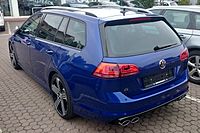



Like the GTI, the Golf R is also built as a three- or five-door hatchback. It is powered by a newly developed version of the 1,984 cc (2.0 L; 121.1 cu in) turbocharged EA888 petrol FSI Inline-four engine used in the latest Golf GTI (and Audi S3), but in this application producing 300 PS (296 bhp; 221 kW) (206 kW (280 PS; 276 bhp) for "hot climate" markets such as Australia, South Africa, Japan, USA) from 5,500 to 6,200 rpm and 380 N⋅m (280 lb⋅ft) from 1,800 to 5,500 rpm of torque.[55] Compared to the GTI's powerplant, the Golf R's engine has a modified cylinder head, exhaust valves, valve seats and springs, pistons, injection valves and larger intercooler and turbocharger. DSG equipped models also come with an auxiliary oil cooler on the passenger side on right hand drive models.
0-62 mph (100 km/h) takes 5.1 seconds (versus 5.7 seconds for previous Golf R), or 4.9 seconds with optional DSG gearbox. The top speed is electronically limited to 155 mph (249 km/h). Despite this increased performance, a combined fuel consumption of 39.8 miles per imperial gallon (7.10 L/100 km; 33.1 mpg‑US), and CO
2 emissions of 165 g/km (159 g/km DSG) make the Golf R up to 18 percent more efficient than its predecessor.
The R uses an updated, fifth-generation Haldex 4MOTION four-wheel drive system. Under low loads or when coasting, the rear axle is decoupled, helping to reduce fuel consumption. Drive to the rear axle can be engaged in fractions of a second via the Haldex coupling, which is actuated by an electro-hydraulic pump. Up to 50 percent of power can be transferred to the rear axle. A brake actuated, XDS+ system mimics a limited-slip differential by applying the brakes to the wheel with the least traction, this is on both the front and rear axles.
The ride height is 20 mm lower than the standard Golf. Golf R models equipped with the optional 'DCC' (Dynamic Chassis Control), offer three suspension modes: 'Comfort', 'Normal', and 'Race'. Each mode adjusts the stiffness of the suspension damping, thereby offering drivers a way to change the way the vehicle responds by the push of a button. Comfort mode places the dampers in the softest setting, increasing the absorption of road imperfections allowing for a smoother and more comfortable ride. Race mode stiffens the dampers to their most aggressive setting, reducing body movements and increasing adhesion to the road for more precise high speed driving. Race mode also increases throttle response, firms up the steering for a heftier feel, and alters the shift pattern of the DSG gearbox (where fitted) as well as increases the speed of the Adaptive headlamps (AFS) response time.
On top of ESC Sport mode, as found on the GTI and GTD, which delays intervention of the electronic stability control system, the R offers the option fully to disengage the ESC, for track driving.
For the Canadian market, the optional Discover Pro 8" infotainment system is available as part of the single option "Technology Package", while only the 6.5" Discover is available to US consumers. In North America The Golf R comes standard with halogen tail lights and HID Bi-Xenon Headlight with LED front and side view mirror turn signals, while ROW markets received the options for a sunroof, a three door version, and LED tail lights. All these features are not available to the North American version. The Golf R and e-Golf are the only Golf models available in North America still produced in Germany. Other Golf models for the North American market are produced by Volkswagen de México in Puebla, Mexico.
A limited edition Golf R400 was rumored in August 2015 by Heinz-Jakob Neusser, then-head of brand development, but in the wake of the Volkswagen emissions scandal (and Neusser's suspension) it was cancelled in favor of focusing on the Golf R.
For the South African market the Golf R received another upgrade in power in March 2019. The upgrade resulted in 228 kW and 400 nm of torque (up from 213 kW and 380 nm in the facelift seen in July 2017). Additionally the Golf R also provides the option of fitting an Akrapovic performance exhaust at the factory.[56]
The MK7 Golf R was dropped from US markets in August 2019 to make way for the Volkswagen Golf MK8 in 2020.
Facelift[]
In November 2016, Volkswagen revealed a facelifted version of the Golf MK7. This model is referred to as the "New Golf" by Volkswagen while it is often informally referred to as the Golf 7.5. A new engine was introduced along with the facelift; a 1.5 litre TSI which produces 95.6 kW (128.2 hp; 130.0 PS) or 110 kW (148 hp; 150 PS). Initially, the existing 1.4 litre TSI was available alongside this new 1.5 litre engine. The updated Golf GTI was increased from 162 kW (217 hp; 220 PS) to 169 kW (227 hp; 230 PS) in the standard car and from 169 kW (227 hp; 230 PS) to 180.2 kW (241.7 hp; 245.0 PS) with the performance pack. The Golf R similarly had its output increased from 221 kW (296 hp; 300 PS) to 228 kW (306 hp; 310 PS). In addition, the facelift increased infotainment screen size across the range as well as adding the option for a fully digital dashboard. The rear lights now utilise LED technology as standard (including a "sweeping" indicator effect on performance models) while this technology is optional on most models for the headlights.[57]

5-door hatchback (facelift)

5-door hatchback (facelift)

Golf R-Line (facelift)

Golf R-Line (facelift)

Golf Variant (facelift)
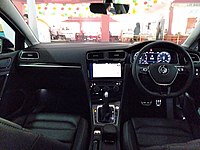
Interior (facelift)
Powertrain[]
The Golf line is available in all the relevant drive systems: the Golf TSI, including GTI, is petrol-powered; Golf TDI, including GTD, is diesel-powered; the Golf TGI is powered by compressed natural gas (CNG); the e-Golf is powered by electricity; and Golf GTE is a plug-in hybrid. The use of a modular transverse matrix assembly kit enables the manufacturing of Golf models with gasoline, diesel, natural gas, electric and hybrid drives from bumper to bumper at Volkswagen factories.[58] Retail deliveries of the e-Golf in Germany began in the second quarter of 2014.[59] U.S. sales started in selected markets during the fourth quarter of 2014.[26] The Golf GTE was launched also in the fourth quarter of 2014.[58]
All internal combustion engines are three- or four-cylinder units:[60]
| Petrol engines | |||||||
|---|---|---|---|---|---|---|---|
| Model | Displacement | Power | Torque | Acceleration 0–100 km/h (0-62 mph) |
Top speed | Transmission | Notes |
| 1.2 TSI BlueMotion | 1,197 cc (73 cu in) | 85 PS (63 kW; 84 hp) at 4,300–5,300 rpm | 160 N⋅m (118 lb⋅ft) at 1,400–3,500 rpm | 11.9 s | 179 km/h (111 mph) | 5-speed manual | |
| 1.2 TSI BlueMotion | 1,197 cc (73 cu in) | 105 PS (77 kW; 104 hp) at 5,000 rpm | 175 N⋅m (129 lb⋅ft) at 1,550–4,100 rpm | 10.2 s | 192 km/h (119 mph) | 6-speed manual 7-speed DSG |
|
| 1.0 TSI BlueMotion | 999 cc (61 cu in) | 115 PS (85 kW; 113 hp) at 5,000–5,500 rpm | 200 N⋅m (148 lb⋅ft) at 2,000–3,500 rpm | 9.7 s | 204 km/h (127 mph) | 6-speed manual 7-speed DSG |
|
| 1.4 TSI BlueMotion | 1,390 cc (85 cu in) | 122 PS (90 kW; 120 hp) at 5,000 rpm | 200 N⋅m (148 lb⋅ft) at 1,400–4,000 rpm | 9.3 s | 203 km/h (126 mph) | 6-speed manual 7-speed DSG |
|
| 1.4 TSI BlueMotion | 1,390 cc (85 cu in) | 125 PS (92 kW; 123 hp) at 5,000–6,000 rpm | 200 N⋅m (148 lb⋅ft) at 1,400–4,000 rpm | 9.1 s | 204 km/h (127 mph) | 6-speed manual 7-speed DSG |
from April 2014 |
| 1.4 TSI BlueMotion | 1,395 cc (85 cu in) | 140 PS (103 kW; 138 hp) at 4,500–6,000 rpm | 250 N⋅m (184 lb⋅ft) at 1,500–3,500 rpm | 8.4 s | 212 km/h (132 mph) | 6-speed manual 7-speed DSG |
|
| 1.4 TSI BlueMotion | 1,395 cc (85 cu in) | 150 PS (110 kW; 148 hp) at 5,000–6,000 rpm | 250 N⋅m (184 lb⋅ft) at 1,500–3,500 rpm | 8.2 s | 216 km/h (134 mph) | 6-speed manual 7-speed DSG |
from April 2014 |
| 1.5 TSI EVO | 1,498 cc (91 cu in) | 150 PS (110 kW; 148 hp) at 5,000–6,000 rpm | 250 N⋅m (184 lb⋅ft) at 1,500–3,500 rpm | 8.1 s | 216 km/h (134 mph) | 6-speed manual 7-speed DSG |
|
| 1.6 FSI | 1,598 cc (98 cu in) | 110 PS (81 kW; 108 hp) at 3050–4800 rpm | 164 N⋅m (121 lb⋅ft) at 3400–4700 rpm | 13.6 s | 190 km/h (118 mph) | 5-speed manual |
Brazil, Chile, Colombia |
| 1.8 TSI | 1,798 cc (110 cu in) | 172 PS (127 kW; 170 hp) at 4,800–6,200 rpm | 270 N⋅m (199 lb⋅ft) at 1,600–4,200 rpm | 7.6 s | 209 km/h (130 mph) | 5-speed manual 6-speed Tiptronic |
North America |
| GTE | 1,395 cc (85 cu in) | GTE Hybrid mode—205 PS (151 kW; 202 hp) at 3,750–6,000 rpm Electric Motor—100 PS (74 kW; 99 hp) Petrol Motor—150 PS (110 kW; 148 hp) |
350 N⋅m (258 lb⋅ft) at 1,500–4,000 rpm | 7.6 s | 222 km/h (138 mph) | 6-speed DSG |
EU |
| GTI | 1,984 cc (121 cu in) | 220 PS (162 kW; 217 hp) at 4,500-6,200 rpm | 350 N⋅m (258 lb⋅ft) at 1,500-4,400 rpm | 6.5 s | 246 km/h (153 mph) | 6-speed manual 6-speed DSG |
|
| GTI (with Performance Package) | 1,984 cc (121 cu in) | 230 PS (169 kW; 227 hp) at 4,700-6,200 rpm | 350 N⋅m (258 lb⋅ft) at 1,500-4,600 rpm | 6.4 s | 250 km/h (155 mph) | 6-speed manual 6-speed DSG |
|
| R | 1,984 cc (121 cu in) | 300 PS (221 kW; 296 hp) at 5,500-6,200 rpm | 380 N⋅m (280 lb⋅ft) at 1,800-5,500 rpm | 4.9 s | 250 km/h (155 mph) | 6-speed manual 7-speed DSG |
CJXC |
| R (Facelift) | 1,984 cc (121 cu in) | 310 PS (228 kW; 306 hp) at 5,500-6,200 rpm | 380 N⋅m (280 lb⋅ft) at 1,800-5,500 rpm | 4.9 s | 250 km/h (155 mph) | 6-speed manual 7-speed DSG |
DJHA |
| R (Update) | 1,984 cc (121 cu in) | 300 PS (221 kW; 296 hp) at 5,500-6,200 rpm | 400 N⋅m (295 lb⋅ft) at 1,800-5,500 rpm | 4.9 s | 250 km/h (155 mph) | 6-speed manual 7-speed DSG |
DNUE |
| Diesel engines | |||||||
| Model | Displacement | Power | Torque | Acceleration 0–100 km/h (0-62 mph) |
Top speed | Transmission | Notes |
| 1.6 TDI BlueMotion (CLHB) | 1,598 cc (98 cu in) | 90 PS (66 kW; 89 hp) at 2750–4800 rpm | 230 N⋅m (170 lb⋅ft) at 1400–2700 rpm | 12.9 s | 185 km/h (115 mph) | 5-speed manual 7-speed DSG |
|
| 1.6 TDI BlueMotion (CLHA) | 1,598 cc (98 cu in) | 105 PS (77 kW; 104 hp) at 3,000–4,000 rpm | 250 N⋅m (184 lb⋅ft) at 1,500–2,750 rpm | 10.7 s | 192 km/h (119 mph) | 5-speed manual 7-speed DSG |
|
| 1.6 TDI BlueMotion (CLHA) | 1,598 cc (98 cu in) | 115 PS (85 kW; 113 hp) at 3,000–4,000 rpm | 250 N⋅m (184 lb⋅ft) at 1,500–3,200 rpm | 10.2 s | 198 km/h (123 mph) | 5-speed manual 7-speed DSG |
|
| 2.0 TDI[61] | 1,968 cc (120 cu in) | 150 PS (110 kW; 148 hp) at 4,400 rpm | 320 N⋅m (236 lb⋅ft) at 1,750–3,000 rpm | 8.6 s | 216 km/h (134 mph) | 5-speed manual | |
| 2.0 TDI BlueMotion (CKFC) | 1,968 cc (120 cu in) | 150 PS (110 kW; 148 hp) at 3,500–4,000 rpm | 340 N⋅m (251 lb⋅ft) at 1,750–3,000 rpm | 8.6 s | 216 km/h (134 mph) | 6-speed manual 6-speed DSG |
|
| GTD (CUNA / DGCA / CUP) | 1,968 cc (120 cu in) | 184 PS (135 kW; 181 hp) at 3,500–4,000 rpm | 380 N⋅m (280 lb⋅ft) at 1,750–3,250 rpm | 7.5 s | 230 km/h (143 mph) | 6-speed manual 6-speed DSG |
|
| Electric motor | |||||||
| Model | Displacement | Power | Torque | Acceleration 0–100 km/h (0-62 mph) |
Top speed | Transmission | Notes |
| e-GOLF (EAGA) | Electric Motor | 136 PS (100 kW; 134 hp) | 290 N⋅m (214 lb⋅ft) | 9.6 s | 150 km/h (93 mph) | Single-speed automatic | 35.8 kWh battery |
| e-GOLF (EAGA) | Electric Motor | 115 PS (85 kW; 113 hp) | 270 N⋅m (199 lb⋅ft) | 9.6 s | 140 km/h (87 mph) | Single-speed automatic | 24.2 kWh battery |
Awards[]


- Car and Driver's 10Best list in 2019[62]
- 2015 North American Car of the Year[63]
- 2015 Motor Trend Car of the Year[64]
- 2013 European Car of the Year[3]
- 2013 World Car of the Year[65]
- 2013 Car of the Year Japan[66]
- 2013–14 Japan's Import Car of the Year
- 2014 What Car?—Best Estate Car (Great Britain)
- 2013 Wheels Car of the Year (Australia)[67]
- 2013 Cars Guide Car of the Year (Australia)[68]
Golf Sportsvan/SV[]
| Volkswagen Golf Sportsvan | |
|---|---|
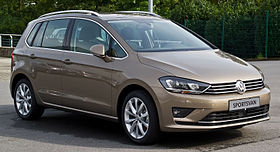 | |
| Overview | |
| Manufacturer | Volkswagen |
| Production | 2014–2020 (Europe) 2016–2020 (China) |
| Assembly |
|
| Body and chassis | |
| Class | Compact MPV (C) |
| Body style | 5-door MPV |
| Layout | Front-engine, front-wheel-drive |
| Platform | Volkswagen Group MQB |
| Related | Volkswagen Golf Mk7 Volkswagen Touran Mk2 |
| Powertrain | |
| Engine | |
| Transmission | |
| Dimensions | |
| Wheelbase | 2,685 mm (105.7 in) |
| Length | 4,338–4,351 mm (170.8–171.3 in) |
| Width | 1,807 mm (71.1 in) |
| Height | 1,578–1,613 mm (62.1–63.5 in) |
| Kerb weight | 1,327–1,535 kg (2,926–3,384 lb) |
| Chronology | |
| Predecessor | Volkswagen Golf Plus |
The Golf Sportsvan or Golf SV is a five-door compact MPV derived from the Golf Mk7 which was produced between 2014 and 2020. Previewed as the Volkswagen Sportsvan concept at the 2013 Frankfurt Motor Show,[69] it is also built on the MQB platform and was assembled at the Wolfsburg plant alongside the standard Golf hatchback. At 4,338 mm long, the new SV is 134 mm longer than the Golf Plus that it replaces, 83 mm longer than the Golf hatchback, and 224 mm shorter than the Golf Estate.
Compared with the boot of its predecessor, the capacity is increased by 76 litres to 500 litres with the back seats at their rear-most position (versus the Golf's 380 litres and the Estate's 605 litres). Moving the rear seats forwards increases the luggage capacity to 590 litres, while folding the rear seats liberates up to 1,520 litres of room. The front passenger seat can also optionally fold fully forward, creating a load space which is up to 2,484 mm long.
Like the Golf, the Golf SV comes with many standard and optional safety systems. These include a standard automatic post-collision braking system, which automatically brakes the vehicle after a collision to reduce kinetic energy significantly and thus minimise the chance of a second impact, and a PreCrash system (Proactive Occupant Protection) which, on detecting the possibility of an accident, pre-tensions seatbelts and closes the windows and sunroof, leaving just a small gap, to ensure the best possible protection from the airbags.
A first for the Golf SV is a blind spot monitor, dubbed Side Scan, with an assistant for exiting parking spaces. This monitors the area behind and to the sides of the vehicle, ensuring easier and safer egress when reversing from a parking bay. It will be packaged as an option together with Lane Assist.

Rear view

2018 Golf Sportsvan (facelift)

2018 Golf Sportsvan (facelift)

Interior
Powertrain[]
Powering the SV is a range of petrol and diesel engines, all of which incorporate Stop/Start and battery regeneration systems. There are two turbocharged 1.2-litre petrol engines with 85 and 110 PS; two 1.4-litre turbocharged petrol engines with 125 and 150 PS; and three turbodiesels: a 2.0-litre 150 PS, a 1.6-litre 90 PS and a 1.6-litre 110 PS. When fitted in the Golf SV BlueMotion, this last engine is expected to return fuel economy of 76.3 mpg and emit 95 g/km of CO2. All engines apart from the 1.2-litre TSI 85 PS can be ordered with a DSG gearbox.
Annual American sales[]
| Calendar year | Golf | GTI | Golf R | e-Golf | Golf SportWagen/Alltrack | Total U.S. sales |
|---|---|---|---|---|---|---|
| 2015[70] | 19,257 | 23,669 | 4,141 | 4,232 | 14,009 | 65,308 |
| 2016[71] | 13,764 | 23,934 | 4,493 | 3,937 | 15,559 | 61,687 |
| 2017[71] | 13,552 | 22,486 | 2,706 | 3,534 | 26,700 | 68,978 |
| 2018[72] | 6,642 | 16,684 | 3,468 | 1,354 | 14,123 | 42,271 |
| 2019[72] | 5,644 | 11,672 | 4,223 | 4,863 | 10,991 | 37,393 |
| 2020[73] | 6,063 | 11,461 | 1,193 | 767 |
References[]
- ^ "Golf-vii engines & performance". Volkswagen UK. Retrieved 14 July 2015.
- ^ "Golf-gti-vii engines & performance". Volkswagen UK. Retrieved 14 July 2015.
- ^ Jump up to: a b "Car of the Year 2013: VW Golf does it again". caroftheyear.org. 4 March 2013. Archived from the original on 7 March 2013. Retrieved 4 March 2013.
- ^ Kable, Greg (4 September 2012). "2013 Volkswagen Golf revealed". Autocar. Retrieved 4 September 2012.
- ^ Auto, Motor und Sport (7 November 2012). "VW Golf VII: Markteinführung am Samstag" [VW Golf VII: Market introduction during saturday]. auto motor und sport (in German). Archived from the original on 15 July 2015. Retrieved 14 July 2015.
- ^ GmbH, Frankfurter Allgemeine Zeitung (10 November 2016). "Weltpremiere in Wolfsburg: VW hat den Golf renoviert". FAZ.NET.
- ^ Gilboy, James (3 October 2019). "2020 Volkswagen Golf MK8 Set for October 24 Debut in Wolfsburg: Report". The Drive.
- ^ Jump up to: a b "VW Gläserne Manufaktur - 16.155 e-Golf: Gläserne Manufaktur 2019 mit Allzeit-Produktionsrekord". VW Gläserne Manufaktur (in German). Retrieved 22 January 2020.
- ^ "Produktion des ID.3 im Werk Zwickau startet im November". Volkswagen Newsroom (in German). Retrieved 22 January 2020.
- ^ Kable, Greg (4 September 2012). "Volkswagen Golf Mk7 engine line-up announced". Autocar. Retrieved 4 September 2012.
- ^ "World premiere of the new Golf in Berlin". Volkswagen AG. 4 September 2012. Archived from the original on 24 May 2015. Retrieved 16 September 2012.
- ^ "Modelle < Volkswagen Deutschland". Retrieved 14 July 2015.
- ^ "2015 Volkswagen Golf: The best hatchback just got even better". Volkswagen US Media Newsroom. Volkswagen. Archived from the original on 29 November 2014. Retrieved 5 December 2014.
- ^ "Volkswagen Golf 1.4 TSI (2013) CAR review | Road Testing Reviews | Car Magazine Online". Carmagazine.co.uk. 16 January 2013. Retrieved 21 February 2013.
- ^ TMR Team (18 April 2013). "New 2013 Volkswagen Golf 7 On Sale In Australia". themotorreport.com.au. Retrieved 24 January 2014.
- ^ "Auto Esporte—Novo Golf custará a partir de R$ 67.990; veja todos os preços". Auto Esporte. 7 September 2013. Retrieved 14 July 2015.
- ^ "Volkswagen Golf passará a ser importado do México". Retrieved 14 July 2015.
- ^ "pdf" (PDF). Archived from the original (PDF) on 20 October 2016. Retrieved 26 April 2016.
- ^ "Geneva motor show 2013: VW Golf estate revealed". Autocar. Retrieved 1 June 2021.
- ^ Radu, Mihnea (2 March 2013). "This Is the 2013 Volkswagen Golf Variant and Next Jetta SportWagen". autoevolution. Retrieved 1 June 2021.
- ^ Chris Paukert (10 September 2013). "2015 Volkswagen e-Golf is ready to battle the Nissan Leaf". Autoblog.com. Retrieved 10 September 2013.
- ^ Jump up to: a b VW Media Services (15 February 2014). "Volkswagen launches the battery-electric e-Golf in Germany; "Das e-Auto"". Green Car Congress. Retrieved 16 February 2014.
- ^ Mike Szostech. "Volkswagen e-Golf gets EPA rated 83 mile range". My Electric Car News. Retrieved 21 October 2014.
- ^ Michaël Torregrossa (10 March 2014). "Volkswagen débute la production de la Golf électrique à Wolfsburg" [Volkswagen starts production of electric Golf in Wolfsburg] (in French). Association pour l'Avenir du Véhicule Electrique Méditerranéen (AVEM). Retrieved 11 March 2014.
- ^ Mike Szostech. "UK e-Golf—orders open, priced at £25,845". Retrieved 19 March 2014.
- ^ Jump up to: a b VW Press Release (14 November 2013). "VW provides details on e-Golf prior to launch at LA Auto Show". Green Car Congress. Retrieved 16 February 2014.
- ^ Mike Szostech. "Volkswagen chooses to drop the liquid cooling on the e-Golf". My Electric Car News. Retrieved 17 April 2014.
- ^ Skogstad, Knut (25 February 2014). "VW e-Golf: Solgte over 1.300 biler—på ni timer" [VW e-Golf: Over 1,300 cars sold—in nine hours]. TV2 / Broom (in Norwegian). Retrieved 25 March 2014.
- ^ Brorstad, Harald (3 March 2014). "Supre salgstall for e-Golf og e-UP!" [Great sales figures for e-Golf and e-UP!]. Motormagazinet (in Norwegian).
- ^ "Volkswagen e-Golf kundepriser per 24.02.2014" [Volkswagen e-Golf retail prices as of 15 February 2014] (PDF) (in Norwegian). Volkswagen. Archived from the original (PDF) on 26 March 2014. Retrieved 25 March 2014.
- ^ "Ny Volkswagen Golf kundepriser per 01.01.2014" [New Golf retail prices as of 1 January 2014] (PDF) (in Norwegian). Volkswagen. Archived from the original (PDF) on 26 March 2014. Retrieved 25 March 2014.
- ^ Norwegian Road Federation (OFV) (August 2014). "Bilsalget i juli" [Car sales in July] (in Norwegian). OFV. Archived from the original on 10 August 2014. Retrieved 23 August 2014. Click on "Modellfordelt" to display the top 20 selling new cars in Norway.
- ^ Automotive Industry Data (AID) (6 August 2014). "Every second electric car sold in Norway this July came from Volkswagen". AID. Retrieved 23 August 2014. In July 2014 the top selling electric cars in Norway were the Volkswagen e-Golf with 391 units, the Nissan Leaf with 313 and the Volkswagen e-Up! with 282.
- ^ Ståle Frydenlund (2 September 2014). "VW e-Golf slår Teslas superstart" [VW e-Golf beats Tesla's super start] (in Norwegian). Norsk Elbilforening (Norwegian Electric Vehicle Association). Archived from the original on 8 September 2014. Retrieved 13 September 2014.
- ^ Norwegian Road Federation (OFV) (September 2014). "Bilsalget i august" [Car sales in August] (in Norwegian). OFV. Archived from the original on 6 September 2014. Retrieved 13 September 2014. Click on "Modellfordelt" to display the top 20 selling new cars in Norway.
- ^ Jose Pontes (29 September 2014). "Europe August 2014". EVSales.com. Retrieved 21 October 2014.
- ^ VW Press Release (25 August 2014). "Volkswagen prices e-Golf in US at $35,445". . Retrieved 26 August 2014.
- ^ VW Press Release (2 December 2014). "VOLKSWAGEN OF AMERICA REPORTS NOVEMBER 2014 SALES". Volkswagen of America. Archived from the original on 10 December 2014. Retrieved 5 December 2014.
- ^ "Configurador < Volkswagen España". Retrieved 14 July 2015.
- ^ "Longer Range Volkswagen e-Golf goes on sale in Germany". My Electric Car Forums. Retrieved 26 June 2018.
- ^ "Volkswagen e-Golf (Chinese market)".
- ^ Mike Millikin (13 March 2014). "Volkswagen: e-mobility and sustainability; Part 1, the e-Golf and Golf GTE". . Retrieved 13 March 2014.
- ^ Mike Millikin (29 September 2014). "Promised VW Passat plug-in hybrid to debut at Paris show; both sedan and wagon". . Retrieved 29 September 2014.
- ^ Noah Joseph (20 February 2014). "VW Golf GTE plugs in the GTI for guilt-free fun". Autoblog.com. Retrieved 29 September 2014.
- ^ Jose Pontes (13 September 2014). "Germany August 2014". EVSales.com. Retrieved 29 September 2014.
- ^ "The Legendary Rabbit Name Makes a 2019 Comeback—Newsroom". newsroom.vw.com. Retrieved 11 February 2019.
- ^ https://www.motorpasion.com.mx/industria/volkswagen-golf-gti-oettinger-precio-versiones-equipamiento-mexico
- ^ Jump up to: a b https://www.topspeed.com/cars/volkswagen/2016-volkswagen-golf-gti-clubsport-ar171153.html
- ^ Jump up to: a b https://www.kbb.com/car-news/2016-volkswagen-gti-clubsport-marks-40th-anniversary/
- ^ Jump up to: a b https://www.autocar.co.uk/car-review/volkswagen/golf-gti/first-drives/2016-volkswagen-golf-gti-clubsport-review
- ^ Jump up to: a b c https://www.evo.co.uk/volkswagen/golf/gti-clubsport
- ^ Jump up to: a b https://www.motoringresearch.com/car-reviews/2016-volkswagen-golf-gti-clubsport-s-review-record-breaking-ace/
- ^ Jump up to: a b https://www.topspeed.com/cars/volkswagen/2016-volkswagen-golf-gti-clubsport-s-ar173178.html
- ^ https://www.autocar.co.uk/car-review/volkswagen/golf-gti/first-drives/2016-volkswagen-golf-gti-clubsport-s-review
- ^ Georg Kacher, ed. (4 February 2014). "VW Golf R 2014 review". carmagazine.co.uk. Retrieved 29 June 2018.
- ^ Jens Meiners (25 April 2016). "With Golf R400 canceled, VW shifts to Golf R". AUTOMOTIVE NEWS. Retrieved 25 April 2016.
- ^ Lette van Oostvoorne, Nick (10 November 2016). "2017 VW Golf Mk7 facelift old vs new compared". Retrieved 5 January 2019.
- ^ Jump up to: a b VW Media (21 February 2014). "Volkswagen to introduce Golf plug-in hybrid at Geneva; first deliveries in autumn". Green Car Congress. Retrieved 21 February 2014.
- ^ Damon Lowney (10 September 2013). "2015 Volkswagen e-Up! shows EV commitment at Frankfurt this season". Autoblog.com. Retrieved 10 September 2013.
- ^ "2013 Volkswagen Golf—"Technik und Preise"" (PDF). Volkswagen AG. 5 September 2012. Archived from the original (PDF) on 12 February 2013. Retrieved 6 September 2012.
- ^ "New Golf 2.0 TDI Comfortline". Volkswagen Group South Africa. Archived from the original on 22 February 2014. Retrieved 17 November 2013.
- ^ "2019 10Best Cars". Car and Driver. 29 November 2018. Retrieved 30 November 2018.
- ^ "North American Car & Truck of the Year". Retrieved 14 July 2015.
- ^ Mike Millikin (13 November 2014). "Volkswagen Golf family named "2015 Motor Trend Car of the Year"". . Retrieved 15 November 2014.
- ^ Steven J. Ewing (28 March 2013). "Volkswagen Golf named 2013 World Car of the Year". Autoblog.com. Retrieved 29 March 2013.
- ^ "Volkswagen Golf Won the 2013-2014 Car of the Year Japan Award". Japan Automobile Importers Association. 23 November 2013. Archived from the original on 3 December 2013. Retrieved 2 December 2013.
- ^ "Wheels COTY: How the Golf won". Wheels. 15 January 2014. Retrieved 16 January 2014.
- ^ "VW Golf Mark VII is 2013 Car of the Year". 5 December 2013. Retrieved 16 January 2014.
- ^ volkswagen.de
- ^ "volkswagen of america reports december sales and 2015 year-end results". media.vw.com.
- ^ Jump up to: a b "VOLKSWAGEN OF AMERICA REPORTS DECEMBER AND 2017 YEAR-END SALES RESULTS". media.vw.com.
- ^ Jump up to: a b "VOLKSWAGEN OF AMERICA REPORTS DECEMBER AND 2019 YEAR-END SALES RESULTS". media.vw.com.
- ^ "Volkswagen of America reports Q4 and 2020 year-end sales results". media.vw.com (Press release). 5 January 2021.
External links[]
| Wikimedia Commons has media related to Volkswagen Golf VII. |
| show |
|---|
| show |
|---|
| show |
|---|
| show |
|---|
- All-wheel-drive vehicles
- Compact cars
- Hatchbacks
- Front-wheel-drive vehicles
- Hot hatches
- Cars introduced in 2012
- Volkswagen vehicles
- Hybrid electric cars
- Plug-in hybrid vehicles
- Station wagons















